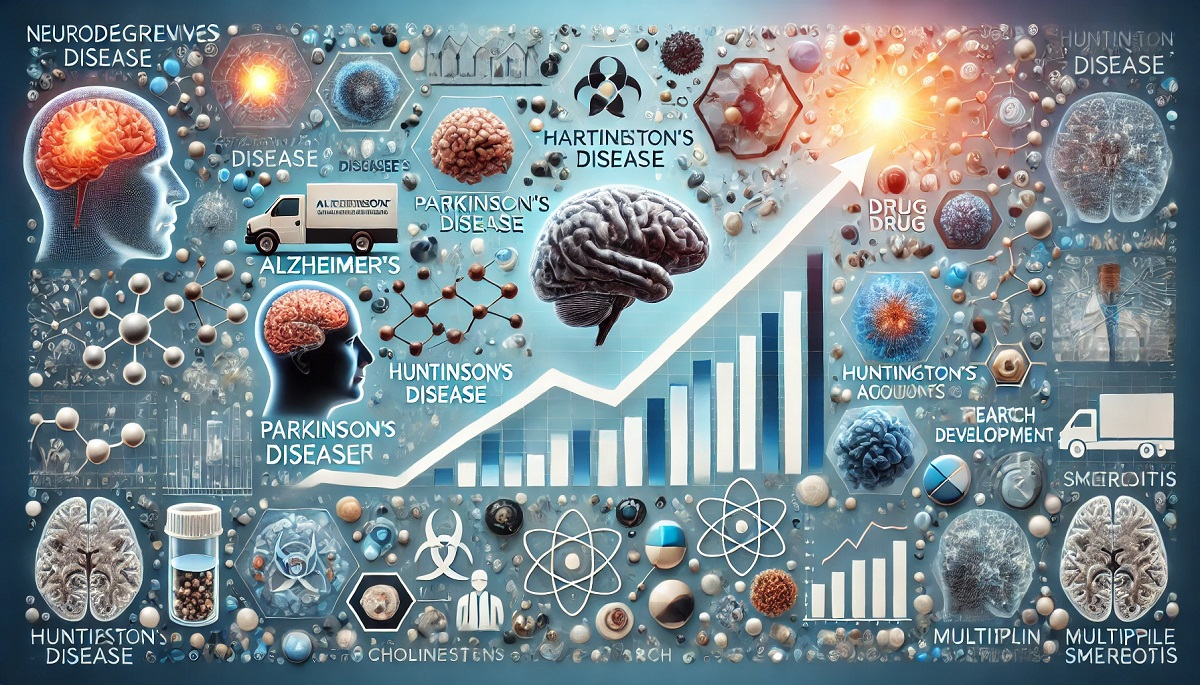Neurodegenerative Disease Market Size and Growth Analysis
The Neurodegenerative Disease Market is projected to grow significantly from 2024 to 2032, driven by advancements in treatment options and rising prevalence of conditions like Alzheimer’s, Parkinson’s, Huntington’s disease, and Multiple Sclerosis. Key drug types include cholinesterase inhibitors and dopamine agonists, with distribution spanning various channels.
The market landscape is shaped by a dynamic partner and customer ecosystem, highlighting product services, key propositions, and competitive strategies.
Regional analysis reveals varying footprints of key players, as companies strive to expand their presence and enhance therapeutic offerings. MarketDigits' comprehensive study provides insights into competitive indices, innovation trends, and strategic growth opportunities.
The Neurodegenerative Disease Market is estimated to be valued at USD 45.8 billion in 2024 and is expected to reach USD 78.7 billion by 2032, growing at a CAGR of 6.2% during the forecast period from 2024 to 2032.
The global Neurodegenerative Disease Market is experiencing robust growth, driven by increasing disease prevalence, advancements in therapeutic research, and a growing geriatric population. The market is expected to witness substantial expansion over the forecast period, supported by enhanced diagnostic capabilities and innovative drug development.
Get the Sample Research Report Copy on Neurodegenerative Disease Market: https://www.marketdigits.com/request/sample/3680
Increasing Demand for the Neurodegenerative Disease Market
Key Factors Driving Market Demand in Recent Years
Aging Global Population: The increasing global life expectancy has resulted in a larger elderly population, which is significantly more susceptible to neurodegenerative diseases such as Alzheimer’s, Parkinson’s, and Huntington’s disease.
According to research published in the National Institutes of Health (NIH), aging is the most significant risk factor for these diseases, and with the global population aged 65+ expected to double by 2050, the demand for neurodegenerative disease treatments has surged.
Advancements in Diagnostic Technologies: Innovations in neuroimaging, biomarker research, and artificial intelligence (AI)-powered diagnostics have enabled earlier and more accurate detection of neurodegenerative diseases. This has led to a rise in diagnosed cases, increasing the demand for effective treatment solutions.
The U.S. FDA has highlighted recent breakthroughs in neurodegenerative diagnostics, emphasizing the growing need for therapeutic interventions.
Surge in Research and Development (R&D) Initiatives: The pharmaceutical and biotech industries have intensified their focus on developing disease-modifying therapies for neurodegenerative disorders.
Increased investment in novel drug discovery, gene therapy, and regenerative medicine has expanded treatment possibilities, further driving market demand.
Research published in PMC underscores the growing number of clinical trials and FDA approvals in this sector.
Rising Public Awareness and Early Diagnosis: Governments, healthcare organizations, and advocacy groups have launched awareness campaigns, resulting in greater public recognition of neurodegenerative diseases.
As a result, more patients are undergoing early screening and diagnosis, boosting the demand for pharmaceutical treatments and supportive therapies.
Projected Factors Driving Market Growth in the Coming Years
Pipeline of Innovative Therapies: Breakthroughs in gene therapy, stem cell research, and precision medicine are expected to revolutionize neurodegenerative disease treatment.
Multiple new therapies are currently in advanced clinical trials, and as they receive approvals, the market demand is expected to rise significantly.
The FDA has emphasized fast-tracking innovative neurodegenerative treatments, reinforcing future market expansion.
Expansion of Healthcare Infrastructure in Emerging Economies: The growth of healthcare infrastructure and greater access to specialized medical services in emerging markets such as India, China, and Brazil will boost early diagnosis and treatment rates.
Investments in neurological care facilities and treatment centers are expected to significantly expand patient access to neurodegenerative disease management in these regions.
Top Expansions, Partnerships, and R&D Initiatives in the Neurodegenerative Disease Market
Leading pharmaceutical companies are actively expanding their presence in the neurodegenerative disease market through strategic acquisitions, partnerships, and research and development (R&D) investments. These initiatives aim to accelerate drug discovery, enhance treatment options, and strengthen global market positioning. Below are the most recent and significant developments from key players in the industry.
AbbVie Inc. | Acquisition of Cerevel Therapeutics
In August 2024, AbbVie Inc. completed the acquisition of Cerevel Therapeutics for $8.7 billion. This strategic move aims to enhance AbbVie’s neuroscience portfolio with innovative treatments targeting neurodegenerative diseases such as Parkinson’s disease, Alzheimer’s disease, and other central nervous system (CNS) disorders.
Collaboration with Tentarix Biotherapeutics
In February 2024, AbbVie announced a strategic collaboration with Tentarix Biotherapeutics to develop conditionally active, multi-specific biologics targeting neurological, immunological, and oncological disorders.
This partnership is expected to advance research in novel neurodegenerative disease treatments by using Tentarix’s proprietary Tentarix™ platform.
Biogen Idec | Acquisition of Reata Pharmaceuticals
In July 2023, Biogen Inc. acquired Reata Pharmaceuticals in a $6.5 billion deal, strengthening its neurology and rare disease portfolio.
The acquisition includes Reata’s drug SKYCLARYS (omaveloxolone), the first FDA-approved treatment for Friedreich’s Ataxia, a rare neurodegenerative disease.
This acquisition reinforces Biogen’s focus on developing transformative therapies for neurological disorders.
Strategic Partnership with Sangamo Therapeutics
Biogen and Sangamo Therapeutics continue their global licensing collaboration to advance gene regulation therapies for neuromuscular and neurological diseases, including Alzheimer’s disease and amyotrophic lateral sclerosis (ALS).
The partnership utilizes Sangamo’s proprietary zinc finger protein technology to develop precise gene therapies aimed at slowing disease progression.
UCB SA | Acquisition of Zogenix
In March 2022, UCB SA completed the acquisition of Zogenix, further expanding its neurology pipeline. This acquisition brings Fintepla®, a breakthrough treatment for Dravet syndrome, a severe form of epilepsy.
While primarily an epilepsy treatment, Fintepla’s mechanism may contribute to future neurodegenerative disease therapies.
Partnership with Novartis on Parkinson’s disease Treatment
In July 2022, UCB entered a partnership with Novartis to co-develop and commercialize UCB0599, an oral, brain-penetrant small molecule alpha-synuclein misfolding inhibitor.
The drug is currently in Phase 2 clinical trials for the treatment of Parkinson’s disease, aiming to slow disease progression by targeting the underlying causes of neurodegeneration.
Get the complete view of 192 Pages Market Research Report on Neurodegenerative Disease: https://www.marketdigits.com/neurodegenerative-disease-market-1700726960
Top Technologies and Innovations in the Neurodegenerative Disease Market (2024-2025)
AbbVie Inc.
Acquisition of Aliada Therapeutics: In October 2024, AbbVie acquired Aliada Therapeutics for $1.4 billion, a move designed to enhance AbbVie’s capacity in treating neurodegenerative diseases such as Alzheimer’s.
This acquisition will help advance drug delivery technologies that can cross the blood-brain barrier, a significant challenge in treating central nervous system (CNS) disorders.
Biogen Idec
Gene Therapy for Neurodegenerative Diseases: Biogen is advancing gene therapy as a potential treatment for Alzheimer’s and Parkinson’s disease. The company is leveraging cutting-edge gene editing technologies to address the root causes of these conditions, focusing on personalized treatments that can offer lasting effects.
Biogen’s emphasis on gene therapy aims to repair or replace faulty genes involved in neurodegenerative diseases, marking a breakthrough in disease-modifying therapies.
Boehringer Ingelheim International GmbH
Alpha-Synuclein Inhibitors for Parkinson’s Disease: Boehringer Ingelheim is progressing with the development of alpha-synuclein inhibitors, which target a protein crucial to the development of Parkinson’s disease.
These inhibitors are designed to reduce protein aggregation in the brain, a hallmark of the disease, and could potentially slow disease progression. Clinical trials are currently underway, with results expected in 2025.
F. Hoffmann-La Roche Ltd
Trontinemab for Alzheimer’s Disease: Roche is developing Trontinemab, an antibody that crosses the blood-brain barrier to target amyloid plaques in the brain, which are closely associated with Alzheimer’s disease. Initial Phase 2 trials have shown positive outcomes, including reduced side effects at low doses.
Final Phase 2 results are anticipated in early 2025, which could pave the way for Phase 3 trials.
Novartis AG
Gene Therapy for Spinal Muscular Atrophy (SMA): Novartis has made significant strides with Zolgensma, a gene therapy developed for Spinal Muscular Atrophy (SMA). Approved in 2019, this therapy has demonstrated transformative effects in treating SMA in children.
With over 1,000 patients treated globally as of 2024, Zolgensma offers hope for improved neurological outcomes in patients with this severe genetic disorder.
Get a Discount on the Premium Research Report on Neurodegenerative Disease Market: https://www.marketdigits.com/request/discount/3680
Frequently Asked Questions (FAQs) on Neurodegenerative Diseases
1. What are the top 5 neurodegenerative disorders?
The top five most prevalent neurodegenerative disorders are as follows:
Alzheimer's Disease: Characterized by progressive memory loss and cognitive decline, Alzheimer's is one of the most common neurodegenerative diseases, particularly affecting the elderly.
Parkinson's Disease: This disorder primarily affects movement control, resulting in symptoms such as tremors, stiffness, and bradykinesia (slowness of movement).
Huntington's Disease: An inherited disorder causing the progressive degeneration of nerve cells in the brain, leading to cognitive, motor, and psychiatric symptoms.
Amyotrophic Lateral Sclerosis (ALS): ALS impacts nerve cells in both the brain and spinal cord, causing a loss of muscle control and eventual paralysis.
Multiple System Atrophy (MSA): A rare condition that affects multiple areas of the nervous system, leading to symptoms similar to Parkinson’s disease, such as movement difficulties and autonomic dysfunction.
2. What is the economic burden of neurodegenerative disease?
Neurodegenerative diseases impose a significant economic burden globally. In the United States, Alzheimer's disease and related dementias account for an annual cost of approximately $352 billion.
This includes direct medical costs, long-term care, and out-of-pocket expenses for families. Specifically, Medicare covers around $179 billion, while Medicaid contributes about $58 billion, with $75 billion being spent by patients and their families for out-of-pocket expenses.
In total, the economic burden of major neurological diseases in the United States has been estimated to be around $800 billion annually, with Alzheimer’s and other dementias being the primary contributors.
3. What is the rarest neurodegenerative disease?
Creutzfeldt-Jakob Disease (CJD) is considered one of the rarest neurodegenerative diseases. This rapidly progressive and fatal disorder is caused by prions, which lead to severe cognitive and motor impairments.
The incidence of CJD is extremely low, with an estimated occurrence of approximately 1 case per 1 million people each year worldwide.
4. What is the fastest growing neurological disorder?
Parkinson's disease is the fastest-growing neurological disorder worldwide. The number of individuals diagnosed with Parkinson's disease has significantly increased, with the global prevalence doubling from 1990 to 2015, reaching over 6 million cases.
This figure is projected to more than double again by 2040, with an expected 12 million cases due to the aging global population.
Other Trending Reports
4D Printing in Healthcare Market: https://www.marketdigits.com/4d-printing-in-healthcare-market-1706776104
Vaccine Adjuvants Market: https://www.marketdigits.com/vaccine-adjuvants-market-1706874377
Cell Culture Media Market: https://www.marketdigits.com/cell-culture-media-market-1707118453
Refurbished MRI Systems Market: https://www.marketdigits.com/refurbished-mri-systems-market-1707118453
Mental Health Software Market: https://www.marketdigits.com/mental-health-software-market-1707206292
Advanced Therapy Medicinal Products Market: https://www.marketdigits.com/advanced-therapy-medicinal-products-market-1707206292
Cell Expansion Market: https://www.marketdigits.com/cell-expansion-market-1707206292
Cancer Immunotherapy Market: https://www.marketdigits.com/cancer-immunotherapy-market-1707902796
Hyaluronic Acid Market: https://www.marketdigits.com/hyaluronic-acid-market-1707902796
Neuromodulation Market: https://www.marketdigits.com/neuromodulation-market-1708610489



